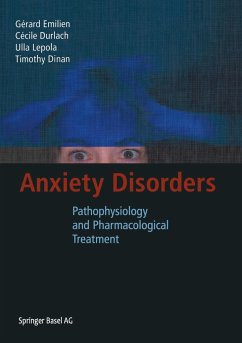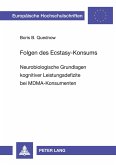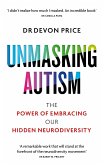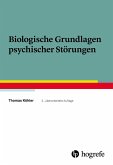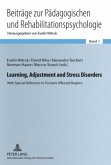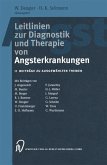Gerard Emilien, Timothy Dinan, Ulla Lepola, Cecile DurlachPathophysiology and Pharmacological Treatment
Anxiety Disorders
Pathophysiology and Pharmacological Treatment
Mitwirkender: Emilien, Gerard; Lepola, Ulla; Durlach, Cecile
Gerard Emilien, Timothy Dinan, Ulla Lepola, Cecile DurlachPathophysiology and Pharmacological Treatment
Anxiety Disorders
Pathophysiology and Pharmacological Treatment
Mitwirkender: Emilien, Gerard; Lepola, Ulla; Durlach, Cecile
- Gebundenes Buch
- Merkliste
- Auf die Merkliste
- Bewerten Bewerten
- Teilen
- Produkt teilen
- Produkterinnerung
- Produkterinnerung
In this book, the discussion of the normal and pathological aspects of anxiety is critically examined. A chapter on the molecular basis of anxiety is included, outlining the potential of such approach in the discovery of novel effective pharmacological interventions. The face validity, predictability and usefulness of animal models in the design of valid new efficacious products are discussed. Separate chapters dedicated to each particular type of anxiety such as generalized anxiety disorder, social phobia, posttraumatic stress disorder, panic and obsessive-compulive disorder are included.…mehr
Andere Kunden interessierten sich auch für
![Folgen des Ecstasy-Konsums Folgen des Ecstasy-Konsums]() Boris B. QuednowFolgen des Ecstasy-Konsums85,90 €
Boris B. QuednowFolgen des Ecstasy-Konsums85,90 €![Unmasking Autism Unmasking Autism]() Devon PriceUnmasking Autism17,89 €
Devon PriceUnmasking Autism17,89 €![Biologische Grundlagen psychischer Störungen Biologische Grundlagen psychischer Störungen]() Thomas KöhlerBiologische Grundlagen psychischer Störungen34,95 €
Thomas KöhlerBiologische Grundlagen psychischer Störungen34,95 €![Learning, Adjustment and Stress Disorders Learning, Adjustment and Stress Disorders]() Learning, Adjustment and Stress Disorders129,65 €
Learning, Adjustment and Stress Disorders129,65 €![Biologie der Angst Biologie der Angst]() Gerald HütherBiologie der Angst20,00 €
Gerald HütherBiologie der Angst20,00 €![Advanced Abnormal Psychology Advanced Abnormal Psychology]() Michel Hersen / Vincent B. Van Hasselt (eds.)Advanced Abnormal Psychology77,99 €
Michel Hersen / Vincent B. Van Hasselt (eds.)Advanced Abnormal Psychology77,99 €![Leitlinien zur Diagnostik und Therapie von Angsterkrankungen Leitlinien zur Diagnostik und Therapie von Angsterkrankungen]() Leitlinien zur Diagnostik und Therapie von Angsterkrankungen54,99 €
Leitlinien zur Diagnostik und Therapie von Angsterkrankungen54,99 €-
-
-
In this book, the discussion of the normal and pathological aspects of anxiety is critically examined. A chapter on the molecular basis of anxiety is included, outlining the potential of such approach in the discovery of novel effective pharmacological interventions. The face validity, predictability and usefulness of animal models in the design of valid new efficacious products are discussed. Separate chapters dedicated to each particular type of anxiety such as generalized anxiety disorder, social phobia, posttraumatic stress disorder, panic and obsessive-compulive disorder are included. This book should be of benefit to psychiatrists, clinical psychologists, general practitioners, nurses, students and all those engaged in neuropsychiatric research.
Produktdetails
- Produktdetails
- Verlag: Springer, Basel
- Artikelnr. des Verlages: 10863426
- 2002
- Seitenzahl: 324
- Erscheinungstermin: 1. März 2002
- Englisch
- Abmessung: 260mm x 183mm x 24mm
- Gewicht: 840g
- ISBN-13: 9783764367022
- ISBN-10: 3764367024
- Artikelnr.: 10620342
- Herstellerkennzeichnung
- Springer Nature c/o IBS
- Benzstrasse 21
- 48619 Heek
- Tanja.Keller@springer.com
- Verlag: Springer, Basel
- Artikelnr. des Verlages: 10863426
- 2002
- Seitenzahl: 324
- Erscheinungstermin: 1. März 2002
- Englisch
- Abmessung: 260mm x 183mm x 24mm
- Gewicht: 840g
- ISBN-13: 9783764367022
- ISBN-10: 3764367024
- Artikelnr.: 10620342
- Herstellerkennzeichnung
- Springer Nature c/o IBS
- Benzstrasse 21
- 48619 Heek
- Tanja.Keller@springer.com
Emilien, G., Wyeth Lederle, CNS Department, Paris, France / Durlach, C., Wyeth Ayerst Research Worldwide, Paris, France / Lepola, U., Psychiatric Research Clinic of Kuopio, Finland / Dinan, T., University College Cork, Ireland
1:Normal and pathological anxiety.- 1 What is anxiety?.- 1.1 Anxiety in children.- 1.2 Anxiety in the elderly.- 1.3 Personality and anxiety.- 1.4 Cognitive aspects of anxiety.- 1.4.1 Gray neurophysiological model of anxiety.- 1.5 Comorbidity of anxiety disorders.- 1.6 Anxiety scales.- 2 Relevance of laboratory research on anxiety disorders.- 3 Genetic factors and brain imaging.- 4 Management.- 5 Discussion.- 2:Biological basis of anxiety and strategies for pharmacological innovation.- 1 Introduction.- 2 Neurobiology of anxiety disorders.- 2.1 Generalised anxiety disorder.- 2.2 Panic disorder.- 2.3 Social phobia.- 2.4 Post-traumatic stress disorder.- 2.5 Obsessive-compulsive disorders.- 3 Recent development and future anxiolytics.- 3.1 5-HT receptors.- 3.2 GABA receptors.- 3.3 Neuropeptide (CCK, CRF, NPY and NK) receptors.- 3.4 Glutamatergic pathways.- 3.5 Opioid receptors.- 3.6 Neurosteroids.- 3.7 Equilibrium between GABA-benzodiazepine and other receptors.- 3.8 Use of mutant mice.- 4 Discussion.- 3:Generalised anxiety disorder.- 1 Introduction.- 2 Diagnostic.- 3 The phenomenon of worry.- 4 Neurobiology.- 4.1 Imaging studies.- 4.2 Genetics.- 5 Physiopathology.- 6 Epidemiology and natural course.- 7 Treatment.- 7.1 Psychological.- 7.2 Biofeedback.- 7.3 Pharmacological.- 7.3.1 Benzodiazepines.- 7.3.2 Buspirone.- 7.3.3 Venlafaxine.- 7.3.4 SSRIs.- 7.3.5 Tricyclics.- 7.3.6 Other drugs.- 7.3.7 Algorithm for treatment.- 8 Methodology for clinical investigation.- 9 Discussion.- 4:Social phobia.- 1 Introduction.- 2 Diagnosis and comorbidity.- 2.1 Subtypes.- 2.2 Differential diagnosis.- 2.3 Comorbidity.- 2.4 Epidemiology.- 2.5 Natural history.- 2.6 Childhood and adolescence versus adult social phobia.- 3 Pathophysiology.- 3.1 Genetic.- 3.2 Neurophysiology.- 3.3 Neuroimaging.- 3.4 Environment.- 3.5 Gender and cultural differences.- 4 Treatments.- 4.1 Psychological.- 4.2 Pharmacological.- 4.3 Comparison, combination of drug versus cognitive-behavioral therapy.- 4.4 Algorithm for treatment.- 5 Methodology of clinical investigations.- 5.1 Rating scales.- 5.2 Self-assessment questionnaires.- 5.3 Clinician/computer-administered scales.- 5.4 Health Outcome Assessments.- 5.5 Assessment of recovery.- 6 Discussion.- 5:Panic disorder.- 1 Introduction.- 2 Diagnosis and aetiology.- 2.1 Comorbidity.- 2.2 Epidemiology.- 3 Pathophysiology.- 3.1 Autonomic and central nervous system dysfunctions.- 3.2 Brain imaging.- 3.3 Respiratory function and carbon dioxide sensitivity.- 3.4 Genetic.- 3.5 Impact on cognitive processes.- 4 Treatments.- 4.1 Psychological.- 4.2 Pharmacological.- 4.2.1 Benzodiazepines.- 4.2.2 Tricyclic antidepressants.- 4.2.3 SSRIs.- 4.2.4 Other treatments.- 4.2.5 Algorithm for treatment.- 5 Methodology for clinical investigation.- 5.1 Psychometric scales.- 5.2 Assessing response and remission.- 6 Discussion.- 6:Obsessive-compulsive disorder.- 1 Introduction.- 2 Diagnostic.- 2.1 Comorbidity.- 2.2 Epidemiology.- 2.3 Natural history.- 3 Physiopathology.- 3.1 Neurobiology.- 3.2 Brain imaging.- 3.3 Genetics.- 3.4 Cognitive dysfunctions.- 4 Treatment.- 4.1 Psychological treatment.- 4.2 Pharmacological treatment.- 4.2.1 Clomipramine.- 4.2.2 SSRI and the 5-HT receptors.- 4.2.3 Addition of atypical neuroleptics.- 4.2.4 Course of therapy.- 4.2.5 Children.- 4.2.6 Some cultural differences in treatment practice.- 5 Methodology for clinical investigation.- 5.1 Psychometric scales.- 6 Discussion.- 7:Posttraumatic stress disorder.- 1 Introduction.- 2 Epidemiology.- 3 Comorbidity.- 4 Physiological and neurological abnormalities associated with PTSD.- 4.1 Physiological abnormalities.- 4.2 Neurobiology and brain abnormalities.- 5 Cognitive dysfunction associated with PTSD.- 5.1 Assessment of PTSD.- 5.2 Attentional bias: The emotional Stroop test.- 5.3 Memory.- 6 Treatment of PTSD.- 6.1 Psychotherapeutic approach.- 6.1.1 Exposure therapy.- 6.1.2 Anxiety management programs.- 6.1.3 Cognitive therapy.- 6.1.4 Eye movement and desensitisation reprocessing.- 6
1:Normal and pathological anxiety.- 1 What is anxiety?.- 1.1 Anxiety in children.- 1.2 Anxiety in the elderly.- 1.3 Personality and anxiety.- 1.4 Cognitive aspects of anxiety.- 1.4.1 Gray neurophysiological model of anxiety.- 1.5 Comorbidity of anxiety disorders.- 1.6 Anxiety scales.- 2 Relevance of laboratory research on anxiety disorders.- 3 Genetic factors and brain imaging.- 4 Management.- 5 Discussion.- 2:Biological basis of anxiety and strategies for pharmacological innovation.- 1 Introduction.- 2 Neurobiology of anxiety disorders.- 2.1 Generalised anxiety disorder.- 2.2 Panic disorder.- 2.3 Social phobia.- 2.4 Post-traumatic stress disorder.- 2.5 Obsessive-compulsive disorders.- 3 Recent development and future anxiolytics.- 3.1 5-HT receptors.- 3.2 GABA receptors.- 3.3 Neuropeptide (CCK, CRF, NPY and NK) receptors.- 3.4 Glutamatergic pathways.- 3.5 Opioid receptors.- 3.6 Neurosteroids.- 3.7 Equilibrium between GABA-benzodiazepine and other receptors.- 3.8 Use of mutant mice.- 4 Discussion.- 3:Generalised anxiety disorder.- 1 Introduction.- 2 Diagnostic.- 3 The phenomenon of worry.- 4 Neurobiology.- 4.1 Imaging studies.- 4.2 Genetics.- 5 Physiopathology.- 6 Epidemiology and natural course.- 7 Treatment.- 7.1 Psychological.- 7.2 Biofeedback.- 7.3 Pharmacological.- 7.3.1 Benzodiazepines.- 7.3.2 Buspirone.- 7.3.3 Venlafaxine.- 7.3.4 SSRIs.- 7.3.5 Tricyclics.- 7.3.6 Other drugs.- 7.3.7 Algorithm for treatment.- 8 Methodology for clinical investigation.- 9 Discussion.- 4:Social phobia.- 1 Introduction.- 2 Diagnosis and comorbidity.- 2.1 Subtypes.- 2.2 Differential diagnosis.- 2.3 Comorbidity.- 2.4 Epidemiology.- 2.5 Natural history.- 2.6 Childhood and adolescence versus adult social phobia.- 3 Pathophysiology.- 3.1 Genetic.- 3.2 Neurophysiology.- 3.3 Neuroimaging.- 3.4 Environment.- 3.5 Gender and cultural differences.- 4 Treatments.- 4.1 Psychological.- 4.2 Pharmacological.- 4.3 Comparison, combination of drug versus cognitive-behavioral therapy.- 4.4 Algorithm for treatment.- 5 Methodology of clinical investigations.- 5.1 Rating scales.- 5.2 Self-assessment questionnaires.- 5.3 Clinician/computer-administered scales.- 5.4 Health Outcome Assessments.- 5.5 Assessment of recovery.- 6 Discussion.- 5:Panic disorder.- 1 Introduction.- 2 Diagnosis and aetiology.- 2.1 Comorbidity.- 2.2 Epidemiology.- 3 Pathophysiology.- 3.1 Autonomic and central nervous system dysfunctions.- 3.2 Brain imaging.- 3.3 Respiratory function and carbon dioxide sensitivity.- 3.4 Genetic.- 3.5 Impact on cognitive processes.- 4 Treatments.- 4.1 Psychological.- 4.2 Pharmacological.- 4.2.1 Benzodiazepines.- 4.2.2 Tricyclic antidepressants.- 4.2.3 SSRIs.- 4.2.4 Other treatments.- 4.2.5 Algorithm for treatment.- 5 Methodology for clinical investigation.- 5.1 Psychometric scales.- 5.2 Assessing response and remission.- 6 Discussion.- 6:Obsessive-compulsive disorder.- 1 Introduction.- 2 Diagnostic.- 2.1 Comorbidity.- 2.2 Epidemiology.- 2.3 Natural history.- 3 Physiopathology.- 3.1 Neurobiology.- 3.2 Brain imaging.- 3.3 Genetics.- 3.4 Cognitive dysfunctions.- 4 Treatment.- 4.1 Psychological treatment.- 4.2 Pharmacological treatment.- 4.2.1 Clomipramine.- 4.2.2 SSRI and the 5-HT receptors.- 4.2.3 Addition of atypical neuroleptics.- 4.2.4 Course of therapy.- 4.2.5 Children.- 4.2.6 Some cultural differences in treatment practice.- 5 Methodology for clinical investigation.- 5.1 Psychometric scales.- 6 Discussion.- 7:Posttraumatic stress disorder.- 1 Introduction.- 2 Epidemiology.- 3 Comorbidity.- 4 Physiological and neurological abnormalities associated with PTSD.- 4.1 Physiological abnormalities.- 4.2 Neurobiology and brain abnormalities.- 5 Cognitive dysfunction associated with PTSD.- 5.1 Assessment of PTSD.- 5.2 Attentional bias: The emotional Stroop test.- 5.3 Memory.- 6 Treatment of PTSD.- 6.1 Psychotherapeutic approach.- 6.1.1 Exposure therapy.- 6.1.2 Anxiety management programs.- 6.1.3 Cognitive therapy.- 6.1.4 Eye movement and desensitisation reprocessing.- 6

